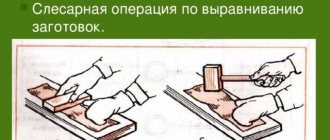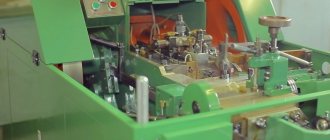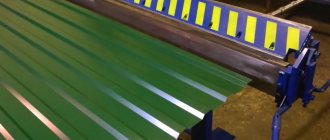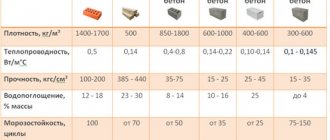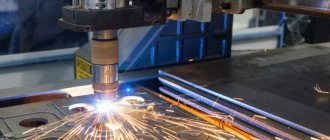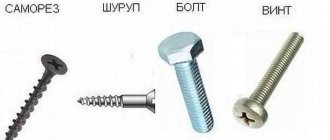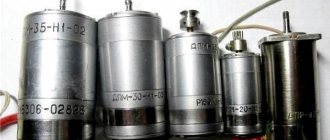Self-tapping screw production technology
This group of products is produced by cold stamping. It is customary to use as raw materials:
- brass;
- steel (standard, stainless or high carbon).
The material is used in the form of wire, which is already twisted into skeins. The production technology of self-tapping screws can be divided into the following stages:
- preparation of the workpiece - cutting the wire to a given size;
- tip and head formation;
- thread formation;
- hardening of the product by rapid heating and cooling in a hardening wheel;
- treatment of the product with anti-corrosion material.
The production line consists of a cold heading and thread rolling machine, as well as a centrifuge for drying the product, a galvanizing line and a hardening furnace. When drawing up a business plan for the production of self-tapping screws, be prepared that more than half of the investment will go to the purchase of equipment. The operating speed of the mini-machine depends on the degree of its productivity and can range from 50 to 250 pieces per minute. The price of the simplest machines (any machine from the entire line) starts from 80 thousand rubles, more complex equipment for the production of self-tapping screws varies between 500-900 thousand rubles. In any case, to purchase a full line you need a starting capital of 600 thousand rubles.
By opening a mini-factory with expensive equipment, you can quickly recoup your initial investment, since the productivity of such technologies is much higher. Profitability will also increase due to the production of higher quality products and the ability to expand the range.
Workers engaged in production
Automated “garage” lines for the production of hardware require the work of one person. To launch a full-fledged enterprise, the number of personnel will need to be increased, not to mention the mandatory staffing if additional stages are introduced into the technological process.
How many and what kind of staff are needed?
At the initial stage, to launch the line, two people will be required to operate the machines and coordinate all processes within the workshop. For this, representatives of working specialties are needed, preferably with secondary technical education. Commissioning and personnel training are often undertaken by the equipment supplier, in which case the costs are included in the cost of the machines.
Calculation of wages for workers
The work schedule of the workshop at the initial stage is standardized, 40 hours a week with a lunch break. Subsequently, depending on sales volumes and customer requirements, the schedule changes to a shift schedule, seven days a week, but in this case two additional staff positions will be required.
Salaries for representatives of blue-collar professions, depending on the region, are set at 15-30 thousand rubles. per month.
Operating principle of the equipment
The operating principle of such equipment, despite the special complex shape of the finished products, is practically no different from the manufacture of conventional nails. First, steel wire of various diameters enters the cutting machine.
The width of the raw material will determine the initial dimensions of the product. Once in the machine, the wire is cut into separate pieces, after which the self-tapping screw head is stamped on the same machine.
The next step is to feed the product into the thread cutting machine. Moreover, the length of the future finished product is determined before the part is fed into this machine.
The next stage will be heat treatment of the part by placing it in a special hardening furnace.
The final stage will be washing of finished parts and anti-corrosion treatment. As a result, the output is a finished fastener, depending on the equipment.
How self-tapping screws are made: hardening
After the threading machine, the fasteners at the factory acquire a shape that is already familiar to everyone. After passing through the flat dies, the almost finished screws are poured into a special hopper and transported to a thermal oven. Previously, such products undergo another quality control at the enterprise.
Firing of fasteners in hot furnaces is quite slow. In this case, heat treatment is usually carried out at temperatures above 930 °C. After the furnace, the self-tapping screws are also fed through the line into special containers with coolant. In this way, the fasteners are hardened.
How much will it cost to produce self-tapping screws - stages of starting a business
Although the production of self-tapping screws is not an original business idea, due to the consistently high demand for the product, the profitability of producing these construction consumables is one of the highest in our state.
If an entrepreneur does not have large expenses for transportation, it is worth opening the production of such a product in towns with a population of 20,000 or more people.
The average expenditure financial plan for starting a business is from 1,200,000 rubles. Start-up capital is highly dependent on machine tool manufacturers. There are both Taiwanese cheap ones and domestic units, the price of which is 2 times higher.
What stages will the individual entrepreneur have to go through on the way to the goal:
- Search for premises for production.
Unlike other areas of business, when manufacturing self-tapping screws, there is no need for an office as such. The entire work process will be automated by 85%, so the main task of the entrepreneur will be to transport products to sales points.
To organize such work, a premises of 30 square meters on the outskirts of the city with access for trucks will do.
In the “handicraft” production of self-tapping screws, it is possible to use large garages, but take into account the size of the machines that will have to work there for 6-9 hours at a time.
- Search for production equipment.
Half of the individual entrepreneurs strive to purchase expensive machines and only premium production lines for self-tapping screws, but this is not correct.
Without permanent sales channels, it is better to save as much as possible and purchase used machines - this will make it possible to “test” the market and adjust production volumes more clearly.
- Arranging supplies of raw materials.
Finding wire for the production of self-tapping screws is not difficult now, but in order to choose the most reasonable price for raw materials, look for it in advance.
- Staff.
You don’t need any special skills to produce self-tapping screws on automated machines. Accordingly, staff salaries will be at the level of 7,000-12,000 rubles. Due to the low profitability of the job, be prepared for staff turnover.
One automated production line of 2-4 machines will require only one worker, but, as a rule, 2 are placed per shift.
Thus, in total you will have to maintain a staff of 4 people.
- Organization of production and sales.
The first candidates for the supply of finished products should be construction stores located in your city. Next, there is coverage of nearby settlements with wholesale distribution points.
Private traders can also purchase self-tapping screws in batches—for beginning entrepreneurs, the share of retail sales often exceeds the wholesale volume.
The average cost of one self-tapping screw is from 30 kopecks per joke. When taking into account monthly expenses for rent and purchase of raw materials for production, the net income of an entrepreneur for a month is from 70,000 rubles.
With a higher markup on the finished product, business profitability can reach 150%, which is one of the best indicators in general for the Russian construction niche.
Machine tools and equipment for self-tapping products
At the core of the process, the production of self-tapping screws is carried out on a small production line. It includes:
- Cold heading equipment
. Conventionally, it is divided into two groups: with a semi-protective casing and a protective casing. They differ in productivity, control system, automation, and product range. The simplest models are focused on the production of one type of product. More expensive machines allow you to expand the range to the production of screws, screws and other types of hardware. The productivity of the machines, on average, is in the range of 40…250 pcs/min. Naturally, prices between simple models and high-performance ones differ several times. Some models can additionally form a drill on the tip of the self-tapping screw. - Thread rolling machine
. Provides thread rolling using a flat replaceable die. It has the ability, depending on the model, to vary the thread pitch. - Thermal hardening furnace.
Gives the self-tapping screw a surface strength on the Brinell scale of at least 55 units. The heating process to a temperature of approximately 1000 degrees Celsius lasts about one minute, followed by cooling (tempering) in a special quenching environment. - Galvanic line.
Designed to form an anti-corrosion coating on the surface of the self-tapping screw. This can be oxidation, phosphating and zinc coating. It consists of several baths where electrochemical reactions for coating are carried out. - Centrifuge
. Dries ready-made self-tapping screws with hot air after washing them from residual chemical solutions during the galvanizing process.
Purchasing one element from the entire production line makes sense if it is to replace completely broken equipment or to replace it with a more advanced device.
To begin a full cycle for the production of self-tapping screws, economic calculations should be made for the entire technological chain.
There are several manufacturers from Europe, China and Taiwan on the market. If we compare the technical parameters, then the most cost-effective would be to purchase a production line in Taiwan. You can combine and create a line of machines from different manufacturers.
For example, you can integrate into the equipment installation process a cold heading machine made in Ukraine (Odessa). The rest of the machines are made in Taiwan or China.
Before starting any business, it is necessary to work out the economic component of the production process. A preliminary analysis of the possible profitability or loss of the project is described in the business plan.
What types of screws are there?
The main purpose of construction consumables is clear from the name itself - using a threaded base to pierce wood/metal and connect structural elements into a single whole. Due to the wide distribution of self-tapping screws, understanding their varieties can be difficult even for a specialized specialist.
However, in the production of self-tapping screws, much attention is paid to the type of product produced. Not everyone has mass demand, so there is no point in buying some molds for machines
Classification of self-tapping screws by purpose
Classic on metal.
The most common version of self-tapping screws, which is optimally produced for the mass consumer. The key feature is that the threads are located very close to each other + the tip of the screws itself has a pointed shape. The length and diameter of the screws do not have general requirements, so this parameter is selected independently during production. To make self-tapping screws for metal, you must use only high-strength steel with galvanization or oxide on top. The color is black, but there are options for metallic or gold plated.
Self-tapping screw for metal with a drill end.
A variant of self-tapping screws, in which a distinctive feature is a drill-shaped tip for smoother penetration into the thickness of the metal. Good for sheet plates of medium thickness. If, when using classic self-tapping screws, you had to use a drill at the initial stage, then you can skip this point here. It is enough to apply some effort, and the self-tapping screw will independently make a starting notch to enter the object.
Self-tapping screw for wood.
You will not notice any major external differences in the production of wood screws. The peculiarity is the greater distance between the turns. On machines and workpieces, this nuance is very easily taken into account and does not require additional purchases of raw materials or replacement parts for machines.
Furniture screw.
A furniture self-tapping screw or, as it is also called, confirmat, is used to assemble structures from MDF or chipboard
You can also use a self-tapping screw for expensive types of wood, but you need to pay great attention to the shape of the cap and the possibility of masking it.
When producing confirmations, the appearance of the hat is of great importance, since each type of furniture may require its own template. It is problematic to produce such self-tapping screws, so the option should be considered only if there are wholesale buyers.
Self-tapping screw with press washer.
The self-tapping screw is a subcategory of metal screws, but due to its functional features it should be considered as a separate production option
The demand for such self-tapping screws is very high in rural areas, so if you are planning to sell your products to such a market, you will not find a better option.
Hex self-tapping screw.
Manufacturing features include a thickened screw body and a hexagonal head for keys. The self-tapping screw can only be used for working with wood and some types of concrete, so this production option should also be considered only if there are wholesale buyers.
Self-tapping screw for roofing.
The name speaks for itself. A special feature in production is that in addition to the self-tapping screw itself, you will also have to make a washer. Cap, diameter, frequency of turns - the parameters are variable and depend on the area of application of the consumable building material.
There are other subtypes of self-tapping screws, but their share in the consumer market does not exceed 10%. Therefore, only those entrepreneurs who already have stable purchasing partners and want to further expand their range as part of the marketing component of the business should focus on such a product.
Business benefits
The commercial side of the business directly depends on the entrepreneur’s literacy and the amount of investment. But even with minimal knowledge and money spent, you can get high profits. The production of self-tapping screws has many advantages:
- The products have a wide range of uses;
- Possibility of creating a wide range;
- Available raw material base;
- A free niche in production (Russia imports huge quantities of self-tapping screws every day).
You can start a business in your own garage, keeping costs to a minimum. This approach will help you quickly reach the break-even point and allow you to think about expansion.
The essence of the business plan and its stages
A good place to start is by searching for potential clients with specific needs. For example, car service stations will require self-tapping screws with an anti-corrosion coating, and furniture companies will need hardware with high strength characteristics
It is important that the buyer is stable: this will allow us to modernize production without any problems in the future, and not depend on market vagaries. Of course, independent sales of goods is also possible, although certain organizational risks will come into play here.
Self-tapping screws are a very popular everyday product
The next important step is to select a suitable production facility. For example, it could be a garage or a large outbuilding. The premises must be suitable not only for carrying out process operations, but also for warehousing/storing finished products.
Having understood the basic requirements for ready-made self-tapping screws, you can address the issues of technology for their production. These requirements include:
- Selection of materials (grade of metal, assortment, type of pre-coating).
- Selection of production equipment models.
- Organization of preparatory and final operations (incoming quality control, packaging, delivery to customers).
- Sales of finished products, if they are intended to be sold independently: advertising, marketing campaigns, etc.
Final stage
The technology described above is the answer to the question of how self-tapping screws are made for wood, metal, stone, etc. In any case, after applying a protective coating, the finished self-tapping screws are fed to the packaging line. They first undergo a final quality control procedure. After such a check, only the most durable fasteners that fully comply with standards and regulations remain.
In large enterprises, the packaging process is usually also fully automated. Special equipment at such factories makes boxes from cardboard blanks, each of which is filled with a certain number of self-tapping screws by weight. Next, the boxes filled with fasteners are assembled into blocks of several pieces and delivered to the finished product dispatch shop.
FULL PRODUCTION CYCLE OF SCREWS
The wire goes through several processing stages before it turns into a self-tapping screw. Forming a workpiece using a cold heading machine. At this stage, the product acquires the desired length, tip, and head. Next, the rod thread is cut on a thread rolling machine. To improve product quality, surface hardening processes can be added to increase product strength and anti-corrosion treatment. After this, the goods are packaged, packed in plastic bags and boxes.
Cold heading technology
The production of self-tapping screw blanks is carried out on two-impact, single-position automatic machines (upsetting machines). The equipment has two punches (roughing and finishing) and one upsetting die.
The prepared wire is installed on the unwinding device and fed through the roller system of the two-plane straightening device into the receiving hole of the cutting matrix. Next, you need to set the adjustable stop to the desired length of the workpiece. After this, the machine is switched on for its working stroke.
The cutting knife performs the cut and, using its clamping feet, transfers the workpiece to the landing position, where the workpiece is picked up by the end of the roughing punch, pushed into the upsetting matrix to the front end of the ejector, after which the head is pre-upsetting.
During the second stroke of the actuator, the tool head rotates, as a result of which the second impact punch is placed in the landing position, which finally shapes the screw head.
During the return stroke of the cold heading machine slide, its ejector removes the stamped workpiece from the cavity of the heading matrix, after which the cycle is repeated. The stamped workpiece enters the tray into the receiving container.
Basic issues of organizing production and commercial activities.
If you do not have your own funds, you must contact the bank for a loan. The bank will begin to consider your application only if you have a meaningful business plan, and will be able to issue a decent loan for organizing a business project. You cannot do without a detailed step-by-step description of the upcoming activity even in the case when the initial capital is already available and you just need to register a legal entity, this could be, for example, an individual entrepreneur (individual entrepreneur) or LLC.
The technology for manufacturing self-tapping screws is simple, but it should be scrupulously analyzed and carefully calculated in advance, before opening a company.
It resembles the production method of a regular nail. The difference between metal fasteners is that the rod has a head and an external thread.
Cold stamping method diagram:
- first, the raw material in the form of twisted wire is sawn crosswise into small bars of the required length;
- then the cap is formed and the thread is cut;
- a mandatory procedure is hardening the resulting screws in the oven;
- products are thoroughly washed;
- A special anti-corrosion coating is easily applied to a clean surface.
To organize production, it is necessary to purchase equipment. The operating line for the production of screws is fully automated:
- The automatic cold heading machine provides rhythmic drawing of wire. The chopped semi-finished products are pushed into a large box;
- The thread rolling mechanism is equipped with special dies that grind threads of a certain size;
- Hardening of finished self-tapping screws occurs in an oven where the temperature is 880-950 ˚C;
- A special galvanizing line consists of several adjacent baths. The screws are moved into a rotating drum, then immersed alternately in a bath with a degreasing composition, in a second container with phosphate, and in a third with oxides. At the final step, the parts are washed with running water. They are now ready to be coated with a layer of zinc;
- The finished screws are dried with a hot air stream in a conventional centrifuge.
The choice of high-quality equipment is a guarantee of uninterrupted production and delivery of finished metal products to the consumer.
Experts recommend purchasing machines and other compact equipment from well-known Taiwanese companies FOB, LianTeng. Their line design is functionally complete (modular), allowing independent stand-alone layout and intermediate diagnostics after each next action. You can buy a machine that produces 50 parts per minute, or you can buy a more expensive one that works at a speed of over 250 screws in the same time. The latest generations of computer-controlled self-tapping equipment are designed for different workpiece lengths and different thread pitches. They have wide possibilities for cutting alternating projections and depressions not only for ordinary screws and screws, even for dowels.
Cold heading machines of the YH1564, YH2076 brands have proven themselves well with an average productivity of 120 and 160 screws per minute. The machines are easy to maintain, they produce excellent quality products, and have a short payback period.
It is also profitable to start the production of self-tapping screws with Chinese semi-automatic machines INNOR and Candid.
In the Russian city of Samara, SAMSTAL LLC produces affordable machines for self-tapping screws of the same name of good quality. CJSC "Monolit", Moscow. LLC "Auto", Kazan. Technoservice Krasnaya Zarya LLC, St. Petersburg. The list of foreign and Russian manufacturers of machines for producing self-tapping screws can be continued for a long time. Many form an operating line from installations and mechanisms from different manufacturers.
When choosing raw materials, many parameters must be taken into account. This includes both the type of products manufactured and the features of equipment for self-tapping screws. For example, it is better to make roofing screws from high-carbon steel with a high hardness coefficient. Wooden elements are usually fastened with stainless steel screws. Brass fasteners do not require additional drilling. They are used in construction when performing finishing work.
You can purchase the material in the form of wire of a specified diameter or in the form of a blank.
There are now many large metal rolling plants in Russia. There are no problems with the supply of raw materials for both small workshops and large enterprises. The fundamental points here can only be the cost of the material and the timing of its delivery.
Ways of implementation
It is recommended to use all possible implementation paths:
- enter into long-term contracts with construction companies;
- work with specialized organizations (for example, for the production of windows, doors, furniture);
- sell products to construction stores and networks;
- interact with private contractors.
Think over your pricing policy. Reasonably low prices for quality products are an obvious way to gain loyal customers. It is also recommended to think through various promotions that encourage customers to buy more and more often.
Develop an assortment. Start producing and selling several varieties of self-tapping screws, identify those that are in demand and focus on them. Nails and anchors can be produced as additional products.
Sales of products
To make a profit, you need to find wholesalers, since retail sales will not bring in much income. An entrepreneur should research the market, study competitors and identify those who need these products. These are furniture factories, hardware stores, building materials hypermarkets. A businessman searches for their contacts on the Internet and sends commercial proposals. Another way to put the production of self-tapping screws on stream is to advertise in print media and place advertisements at virtual “flea markets” and on social networks. It is enough to find two regular customers for the money invested to quickly pay off.
Which dowels are better
Which dowel to choose is a rather trivial question, which actually has a clear answer: you need to choose the dowel that matches the installation material and type of installation. How many times will a master curse a scrolling self-tapping screw when installing a cornice on a foam concrete partition of a house of the 1-LG-600 series? How many people have wrapped an unfortunate dowel with electrical tape, put a cable casing on it, put on a heat-shrinkable tube - and all to no avail!
Who would guess to put two or three pieces in a row and turn them all the way through so that they don’t turn? And how many times will a special expansion dowel be used for gas and foam concrete, not to mention the fact that few suspect, and even fewer know for sure, that such a dowel, it turns out, exists in nature! But a unified classification of dowels, reflected in any regulatory documents, does not exist in nature.
So here, in fact, everything is both simple and quite complicated at the same time. Let's try to figure out what kind of dowels there are in principle:
According to the operating principle
:
1. Spacers, which are held in a hole of a certain diameter due to expansion when screwing in self-tapping screws - the ribs of the spacer dowel rest against the walls of the hole and wedge in it. They are intended for solid materials (concrete, reinforced concrete, asphalt, even wood and wood-based materials).
2. Anchor ones, which, in addition to wedging in the material, are also capable of deforming so that the back part of such a dowel cannot fit into the hole (anchor principle). Such dowels are intended for hollow and porous materials (masonry made of hollow bricks, aerated concrete, foam concrete, etc.), as well as sheet materials such as gypsum board.
By installation method
:
1. Twisting - this long and awkward word speaks for itself and precisely defines the method of installation of this class of dowels. Tightening is done either with a screwdriver of the desired configuration, or with a similarly equipped screwdriver (details below).
2. Driven - similarly, the method of installing such dowels is hammering, usually with a hammer or mallet, but sometimes with the help of other tools: for example, these can be pliers, a wooden block, a fragment of a solid brick or a piece of concrete, a steel angle, etc. .
They also distinguish between through installation, in which part of the dowel is passed through the structure being fixed (has an elongated non-expanding part) and preliminary
, in which the dowel is placed in the hole along its entire length (the most common type of installation).
According to the material of manufacture
:
1. Plastic - made of polyethylene, polypropylene or polyamide (nylon).
2. Metal - made of aluminum alloys, brass, stainless steel.
By type of front part
:
1. With a side (cuff) - when screwed, the side wraps around a screw (screw).
2. Without a side. True, you can get an effect similar to the side if you do not insert the dowel all the way, leaving about 3 mm outside.
By purpose, scope and design features
:
1. Standard dowels for solid materials are the most common type of this type of fastener. The classic version is made of nylon (polyamide), and most of all it is represented on the market by the Finnish company SORMAT (series NAT 5, NAT 6, NAT 8, NAT 10, NAT 12, etc.). In second place is the Swiss manufacturer MUNGO, whose dowels are painted in a characteristic red-orange color and are also made of nylon.
This is a fastener that is suitable in most cases for most materials.
Starting materials and choice of finishing operations
To give strength and presentation, products after cold heading are subjected to cleaning, heat treatment and anti-corrosion/decorative coating. The production technology of self-tapping screws at the final stages is determined by the material from which the products are planted. Depending on the industry of consumption of self-tapping screws, the starting raw material for them is wire from:
- Low-carbon high-quality steel according to GOST 1050. Due to the fact that the material is strengthened during the upsetting process, more expensive rolled products should not be accepted.
- Ductile brass according to GOST 15527 grades from L68 and higher.
- Aluminum grade AD1 according to GOST 4784.
- Plastic alloy D1M according to GOST 14838.
Due to the smallness of the technological gaps, and the need for accurate dosing of the starting material into the upsetting and cutting matrices, the wire assortment must comply with the requirements of GOST 10702. In particular, the material must be supplied in a calibrated state, have an extended gradation of diameters, and have an accuracy class of at least 4.
Taking this into account, for the final operations of releasing self-tapping screws, the following is usually accepted:
- Hardening followed by tempering in vacuum resistance furnaces.
- Blued (it can be black, like iron, or red, like copper). Roofing screws are often blued;
- Galvanizing in electrolytic baths.
- Anodizing (only for self-tapping screws made of aluminum and its alloys).
It makes sense to give a trial batch of finished products for analysis to specialists who, after making the necessary changes in the quality of the coating, hardness, macrostructure of screws, etc. will be able to give a qualified opinion on the quality of the product (and, consequently, on the need to make any changes to the technical process). If everything is in order, then the sale of self-tapping screws wholesale, small wholesale, and retail can start successfully.
Business registration
To register the production of self-tapping screws as a business, it is enough to open an individual entrepreneur . Corresponding OKVED code: 25.94. – “Production of fasteners.”
No special licenses required. An important requirement is that the raw materials must comply with GOST. GOSTs have been developed for finished products : 11652-80 – “Self-tapping screw”, 10619-80, 10618-80, 10620-80, 10621-80, 11651-80. Different types of screws have their own requirements and standards.
Self-tapping screw production technology
The entire technology for the production of metal fasteners can be divided into several key operations:
- Steel wire, which serves as the main raw material for the production of self-tapping screws, is fed to an automatically controlled machine, where an intermediate semi-finished product is formed. The head of the future metal self-tapping screw is immediately pressed using a cold heading process.
- Next, the workpiece is fed along a conveyor belt into the machine, where, with the help of a vibration gripping mechanism, it is sent to form threads in a special machine.
- The next stage is the heat treatment of the workpiece, followed by the removal of large inclusions and washing of the hardware.
- The next operation will be chemical treatment, which is carried out to apply a protective anti-corrosion coating to the metal base.
- Then the final drying of the finished fastener occurs.
- The technological process ends with checking the quality of the part and packaging it.
As you can see, the entire technological process is divided into several different stages, so the production of self-tapping screws will require multifunctional machines.
Necessary raw materials for production
The raw material for the production of self-tapping screws is steel wire or rods made of various types of steel. Certain GOST standards apply to various types of raw materials, in particular, raw materials for cold heading equipment fall under GOST 5663-79. This includes cold-headed wire in coils or coils.
Wire in coils - raw material for the production of self-tapping screws
They buy wire in bulk, in tons, from metal rolling companies. Central Russia has the lowest prices for steel, but high transportation costs due to the large weight of supplies.
| name of raw materials | Size | Price |
| Steel wire GOST 5663-79 | 3-6 mm | 60 thousand rubles/t |
| Low carbon steel wire GOST 17305-91 | 3-6 mm | 52 thousand rubles/t |
How to reduce raw material costs
When thinking about optimizing the cost of raw materials in the price of finished products, you should never skimp on their quality. Replacing high-strength steel with that used for the manufacture of household products will lead to the fact that the screw heads will twist at the slightest excess of torque.
The cost of raw materials is reduced by establishing direct contacts with suppliers, agreements on discounts on shipped volumes and a carefully thought-out logistics and storage scheme.
Wire for the production of self-tapping screws
To produce hardware, it is necessary to select appropriate raw materials. Each specific type of fastener has corresponding requirements according to GOST. All metals differ in their basic characteristics - ductility, hardness, chemical composition, etc. For the production of fasteners, brass, stainless steel and high-carbon steel are most often used.
Due to a number of technical features, wire supplied in reels is more preferable for the manufacture of fasteners
When choosing raw materials, it is important to find out exactly for what purposes the further use of fasteners is planned. The requirements are very different for different types of fastening (wood, metal, plasterboard), as well as the environment in which they will be used (outdoor, indoor, aggressive environment)
In practice, it has been proven that the production of metal fasteners is a profitable and highly profitable business. And if there are reliable buyers of your products, revenue can be very high.
Machines for making self-tapping screws from Chinese and Taiwanese companies are considered to be the highest quality and high-tech. Their equipment is also distinguished by its cheap price characteristics.
Raw materials for making self-tapping screws
The best raw material for manufacturing by cold stamping is wire made of steel (stainless, high-carbon) or brass. Typically, consumables are purchased in the form of reels with winding, less often - in the form of already cut blanks of the required length. The best grades of steel wire are ST 08 KP and ST 10 KP.
The cost of the material is around $600-700 per ton. About 500 thousand units of goods are made from one such reel. You will need 3-4 tons of wire per month, with a total cost of up to $3,000.
